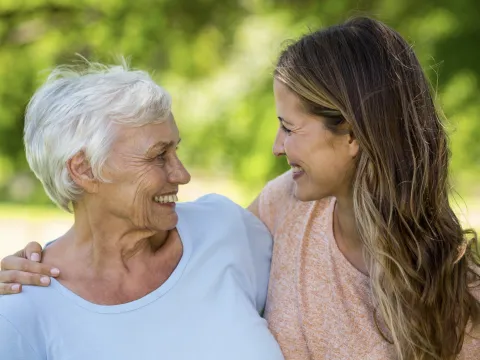- AdventHealth

Unless you work around hazardous materials, you likely only think of burns as heat or fire-related. But the truth is that many burns happen because of chemical burns, too.
Chemical burns happen more often than you think and are actually considered a fairly common household injury.
Understanding what’s needed to care for common household burns — from minor to the most serious — can help ensure you have the right supplies on hand, determine if medical care is needed and help you know where to go for help.
Heat-Related Burns
We’ve all touched a hot stove, gotten splashed by a few drops of boiling water or stayed out in the sun for too long. And while some heat-related burns are minor and will heal without medical care, more severe burns can be dangerous. There are three main categories of heat-related burns:
First-Degree Burns
First degree or “superficial” burns are minor burns that affect only the outer layer of your skin. Symptoms may include:
- Dryness, redness, flaking or peeling
- Pain that lasts for a day or two, and then subsides
- Sensitivity to touch
- Though these burns can be painful, they aren’t serious and can be effectively treated at home with the right supplies and know-how. You may want to keep the following items on hand as a part of your household emergency kit:
- A cold pack (a baggie with ice will work in a pinch)
- Burn ointment (aloe works well for sunburn)
- Pain relief medicines, such as ibuprofen or acetaminophen
To allow your minor burn to get air and heal well, you should avoid bandages.
Second-Degree Burns
What makes a second degree burn a little more serious is that it affects both your outer and second layer of skin, penetrating deeper into your tissues. So, how can you tell if you have a second degree burn? In addition to having first-degree burn symptoms, you’ll likely also experience blisters and discolored, wet- or shiny-looking skin.
Caring for your second-degree burn right away is important so you can avoid infection, heal well and experience as little pain as possible. In most cases you can nurse your second-degree burn at home, but if it covers more than 10% of your body you should seek professional medical care. At home you can soak the affected skin in cold water, apply a burn ointment or cream and then cover the burn with a dry, non-stick bandage. It’s important to clean your burn every day, and to watch for signs of infection.
Should you require medical attention with a second-degree burn for any reason and can wait to schedule an appointment, your primary care provider is your best option. However, if there is an immediate need, you may consider an urgent care facility.
Third-Degree Burns
These serious burns reach the fat layer under your skin. And because they can destroy nerves causing numbness — which means you may not feel any pain — it’s easy to underestimate their severity. If you suspect you or someone you’re helping has a third-degree burn, your best course of action is to move to safety and call 911. You should not attempt to perform any type of first aid or cover the burn.
And, since these burns can affect blood circulation, you should monitor any burn victim you’re helping for signs of shock. Those signs may include confusion, fading in and out of consciousness and a weak pulse.
While very painful and serious — and sometimes life-threatening — you can survive a third-degree burn. However, only a medical care team can properly treat this condition. Treatment for a burn of this severity can include:
- A steady course of antibiotics to help prevent infection
- Cleansing and dressing of the wound (this is an ongoing process)
- Intravenous fluids at the time of the burn incident
- Skin grafting
Chemical Burns
Most of us don’t read (or believe) the warning labels on our household cleaning products and appliances. After all, they seem such a part of our normal routine, and we haven’t experienced any problems — yet. But you may be surprised to learn that every room in your home likely contains hazardous chemicals. In fact, many ordinary cleaning products are actually the most dangerous.
Before you swear off cleaning your house due to safety concerns, know this: cleaning products have been tested for safety and using them as directed shouldn’t cause any health issues. But, if you aren’t intentional about following the directions, or if you accidentally spill them on your skin, you could wind up with a chemical burn. Some of these common household cleaning products are:
- Ammonia can lead to dangerous chemical burns
- Bleach can burn skin, eyes and lungs
- Dishwashing detergents can cause skin irritation and burns
- Drain cleaners contain chemicals that can cause dangerous fumes, skin burns and even blindness if it comes in contact with your eyes
- Furniture polish can irritate your skin, eyes, throat, lungs and windpipe
- Laundry detergents contain sodium or calcium hypochlorite, which can burn your skin or eyes
- Mold and mildew remover may cause breathing problems and severe throat burns if swallowed
- Oven cleaners are extremely corrosive and can burn your skin and eyes
- Toilet cleaners contain bleach and often hydrochloric acid, which can burn your skin
When to See a Doctor
More serious heat-related burns should get treated immediately, as well as chemical burns. Call a doctor if you experience:
- A burn or blister that doesn't heal in two weeks
- New, unexplained symptoms
- Scarring
- Signs of infection, like increased pain, redness and swelling
- If you get a chemical burn, get emergency help right away. It’s okay to play it safe and call 911 if you don't know how severe your injury is. Your health is far too important to take a chance. It’s always better to be safe with an evaluation from your trusted physician.
Take a minute to know where to go if you or a family member needs emergency medical help for a severe burn or another accident or injury. TheERExperts.com is a great place to start.





